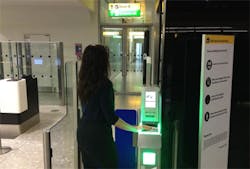Infrared scanners help speed boarding
Passengers at Heathrow airport in London are the first in the world to use a new biometric system as part of the airport's drive to further improve the experience of travelers.
Terminal 1 passengers are being invited to take part in a 'self-boarding' trial in partnership with South African Airways, which uses biometric data to help them board their flight faster and more efficiently.
When passengers reach a 'self-boarding' gate, they pass through an automatic electronic barrier which takes an infrared scan of their face. This information is checked against biometric data that was taken at the check-in stage. When the two sets of data scans are successfully matched, the barrier opens and the passenger can pass through and board their flight.
The system means that a passenger’s identity needs to be checked by airline staff only once in the whole departure process, reducing the time it takes for passengers to get to their aircraft. It also allows airline staff to spend more time with those passengers who require greater assistance.
So far over 300 South African Airways passengers have chosen to use the technology.
Related items from Vision Systems Design that you might also find of interest.
1.Biometric identification system leverages Fourier analysis
Researchers at the Engineering Campus at the Universiti Sains Malaysia have developed a biometric identification system that can identify and validate the veins within the finger of a human being.
2.Biometric identification system uses Basler cameras
The Russian Technoserv Group (Moscow, Russia) is using Basler (Ahrensburg, Germany) cameras for use in their biometric identification systems.
3.Biometric identification system analyzes eye movements
Researchers at the University of Tampere (Tampere, Finland) are developing a biometric security system based on classifying eye movement.
-- Dave Wilson, Senior Editor,Vision Systems Design
